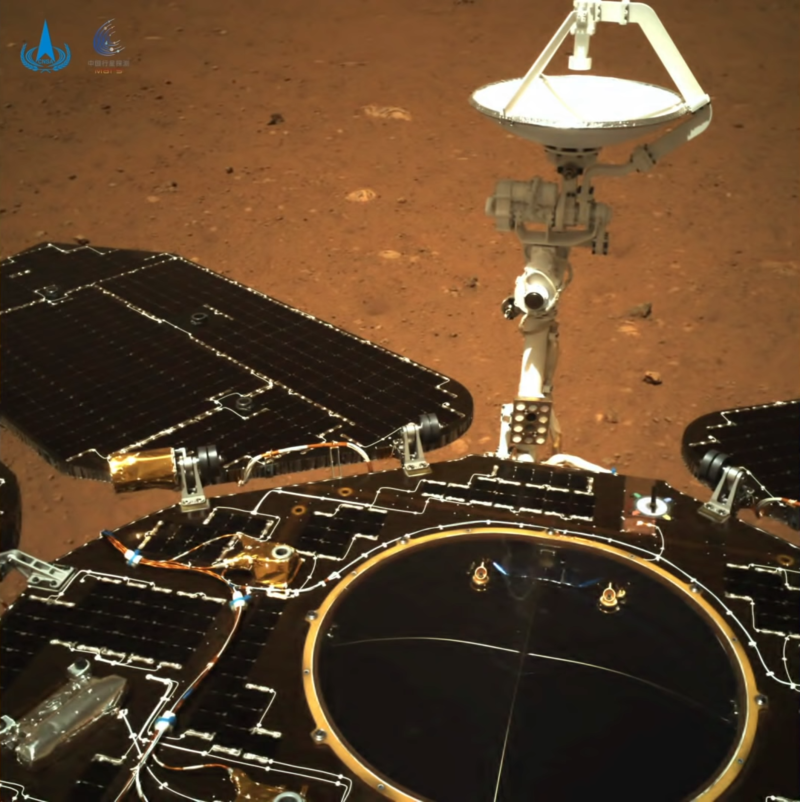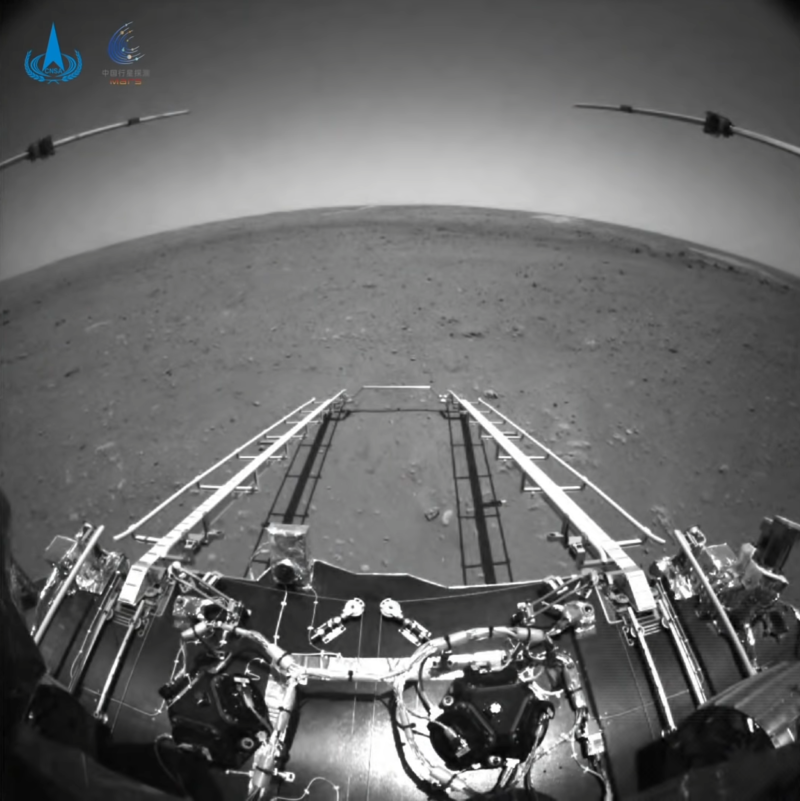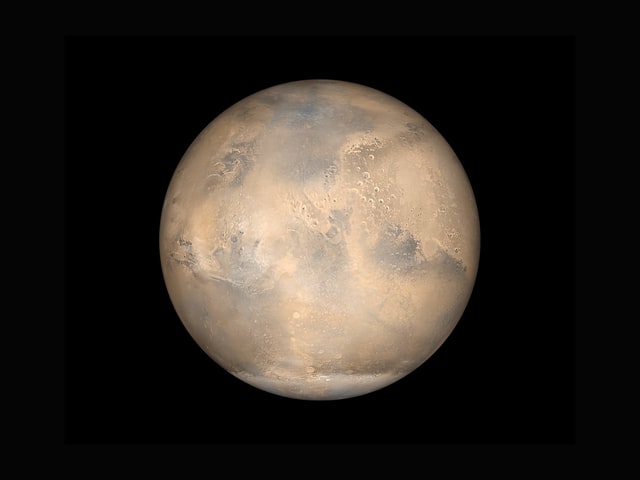
Mars
Mars is the fourth planet from the Sun and the second-smallest planet in
the Solar System, being larger than only Mercury. In English, Mars carries
the name of the Roman god of war and is often referred to as the "Red Planet"
.[16][17] The latter refers to the effect of the iron oxide prevalent on Mars's
surface, which gives it a reddish appearance distinctive among the astronomical
bodies visible to the naked eye.[18] Mars is a terrestrial planet with a thin
atmosphere, with surface features reminiscent of the impact craters of the Moon
and the valleys, deserts and polar ice caps of Earth.
The days and seasons are comparable to those of Earth, because
the rotational period as well as the tilt of the rotational axis
relative to the ecliptic plane are similar. Mars is the site of Olympus
Mons, the largest volcano and highest known mountain on any planet in the
Solar System, and of Valles Marineris, one of the largest canyons in the Solar
System. The smooth Borealis basin in the Northern Hemisphere covers 40% of the planet
and may be a giant impact feature.[19][20] Mars has two moons, Phobos and Deimos, which
are small and irregularly shaped. These may be captured asteroids, similar to 5261 Eureka,
a Mars trojan.
Properties of Mars
Internal structure:
Like Earth, Mars has differentiated into a dense metallic
core overlaid by less dense materials.[64] Scientists
initially determined that the core is at least partially
liquid.[65] Current models of its interior imply a core with
a radius of about 1,794 ± 65 kilometres (1,115 ± 40 mi), consisting
primarily of iron and nickel with about 16–17% sulfur.[66] This iron(II)
sulfide core is thought to be twice as rich in lighter elements as Earth's.
Surface geology:
Mars is a terrestrial plane whose surface consists of
minerals containing silicon and oxygen, metals, and other
elements that typically make up rock. The Martian surface
is primarily composed of tholeiitic basalt,[71] although parts
are more silica-rich than typical basalt and may be similar to
andesitic rocks on Earth, or silica glass.
Soil:
The Phoenix lander returned data showing Martian soil to
be slightly alkaline and containing elements such as magnesium,
 sodium, potassium and chlorine. These nutrients are found in soils
on Earth.
sodium, potassium and chlorine. These nutrients are found in soils
on Earth.
 sodium, potassium and chlorine. These nutrients are found in soils
on Earth.
sodium, potassium and chlorine. These nutrients are found in soils
on Earth.
Hydrology:
Liquid water cannot exist on the surface of Mars due to low
atmospheric pressure, which is less than 1% that of Earth's,[39]
except at the lowest elevations for short periods.[40][41] The two
polar ice caps appear to be made largely of water.[42][43] The volume
of water ice in the south polar ice cap, if melted, would be sufficient
to cover the entire planetary surface to a depth of 11 metres (36 ft).
Polar caps:
Mars has two permanent polar ice caps. During a pole's winter, it
lies in continuous darkness, chilling the surface and causing the
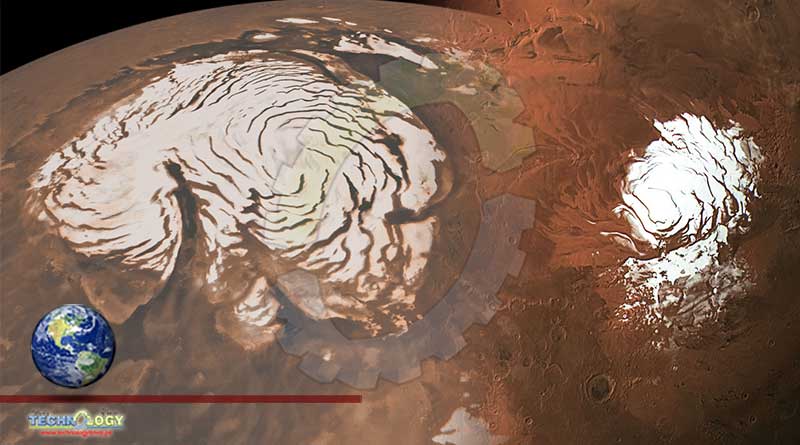 deposition of 25–30% of the atmosphere into slabs of CO2 ice (dry ice).
When the poles are again exposed to sunlight, the frozen CO2 sublimes.
deposition of 25–30% of the atmosphere into slabs of CO2 ice (dry ice).
When the poles are again exposed to sunlight, the frozen CO2 sublimes.
 deposition of 25–30% of the atmosphere into slabs of CO2 ice (dry ice).
When the poles are again exposed to sunlight, the frozen CO2 sublimes.
deposition of 25–30% of the atmosphere into slabs of CO2 ice (dry ice).
When the poles are again exposed to sunlight, the frozen CO2 sublimes.
Geography and naming of surface features:
Although better remembered for mapping the Moon, Johann Heinrich Mädler
and Wilhelm Beer were the first areographers. They began by establishing
that most of Mars's surface features were permanent and by more precisely
determining the planet's rotation period. In 1840, Mädler combined ten years
of observations and drew the first map of Mars.
Map of quadrangles:
For mapping purposes, the United States Geological Survey divides the
surface of Mars into thirty cartographic quadrangles,
each named for a classical albedo feature it contains.
Impact topography:
The dichotomy of Martian topography is striking: northern plains
flattened by lava flows contrast with the southern highlands, pitted
and cratered by ancient impacts. Research in 2008 has presented evidence
regarding a theory proposed in 1980 postulating that, four billion years
ago, the Northern Hemisphere of Mars was struck by an object one-tenth to
two-thirds the size of Earth's Moon.
Volcanoes:
The shield volcano Olympus Mons (Mount Olympus) is an extinct volcano
in the vast upland region Tharsis, which contains several other large
volcanoes. Olympus Mons is roughly three times the height of Mount Everest,
which in comparison stands at just over 8.8 kilometres (5.5 mi).
Holes:
Images from the Thermal Emission Imaging System (THEMIS) aboard NASA's
Mars Odyssey orbiter have revealed seven possible cave entrances on the
flanks of the volcano Arsia Mons.[174] The caves, named after loved ones
of their discoverers, are collectively known as the "seven sisters".[175]
Cave entrances measure from 100 to 252 metres (328 to 827 ft) wide and they
are estimated to be at least 73 to 96 metres (240 to 315 ft) deep.
Atmosphere:
Mars lost its magnetosphere 4 billion years ago, possibly because
of numerous asteroid strikes,[178] so the solar wind interacts
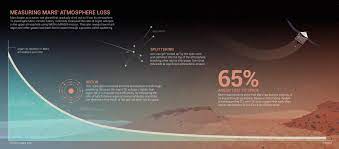 directly with the Martian ionosphere, lowering the atmospheric density
by stripping away atoms from the outer layer.
directly with the Martian ionosphere, lowering the atmospheric density
by stripping away atoms from the outer layer.
 directly with the Martian ionosphere, lowering the atmospheric density
by stripping away atoms from the outer layer.
directly with the Martian ionosphere, lowering the atmospheric density
by stripping away atoms from the outer layer.
Climate:
Of all the planets in the Solar System, the seasons of Mars
are the most Earth-like, due to the similar tilts of the two
planets' rotational axes. The lengths of the Martian seasons
are about twice those of Earth's because Mars's greater distance
from the Sun leads to the Martian year being about two Earth years
long. Martian surface temperatures vary from lows of about −143 °C (−225 °F)
at the winter polar caps[13] to highs of up to 35 °C (95 °F) in equatorial summer.
China's Mars Mission:
Tianwen-1
Tianwen-1 (TW-1; simplified Chinese: 天问; traditional Chinese: 天問; lit.
Heavenly Questions) is an interplanetary mission by the China National Space
Administration (CNSA) to send a robotic spacecraft to Mars , consisting of 5
spacecraft: an orbiter, deployable
camera, lander, drop camera, and the Zhurong rover.[14] The spacecraft, with a
total mass of nearly five tons, is one of the heaviest probes launched to Mars
and carries 13 scientific instruments. It is the first in a series of planned
missions undertaken by CNSA as part of its Planetary Exploration of China program.
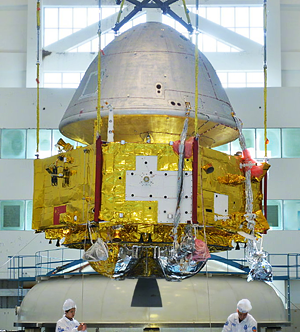
On 22 May 2021, the Zhurong rover drove onto the Martian surface via
the descent ramps on the landing platform.[20][21] With the successful
deployment of the rover, China became the second nation to accomplish
this feat, after the United States,[4][22] as well as the first nation
to orbit, land and release a rover during its first foray into Martian space.
At 23:18 UTC, on 14 May 2021, the Tianwen-1 lander successfully landed in the
preselected landing area in the southern part of the Mars Utopia Planitia.
The landing phase began with the release of the protective capsule containing
the lander/rover. The capsule made an atmospheric entry followed by a descent
phase under parachute, after which the lander used retro-propulsion to soft-land
on Mars .
On May 19, 2021, the China National Space Administration (CNSA) released for
the first time images showing the preparation of the final transfer of the Zhurong rover
from the platform of the lander to the Martian soil. The photographs show the solar panels
of Zhurong already deployed while Zhurong is still perched on the lander.[42][43] The long
delay for the publication of the first images is explained by the short periods of time when
the Zhurong rover and the orbiter are in radio contact and can effectively communicate and
transfer data.[
